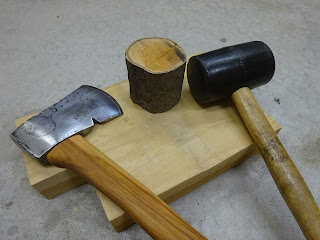I've done a fair amount of reading about working with green wood, but don't generally have access to fresh-cut wood, so I have a lot of questions. I suppose that's normal when doing something for the first time. I took a limb of a pittosporum down the other day and thought I'd try to make some spoons. Our pittosporum trees are evergreen, about 25 feet tall, with trunks of 6-8" diameter.
I know nothing about the wood of the pittosporum. An internet search was fruitless. No idea if the wood is good for anything other than holding the tree upright. Is it toxic or allergenic? Is the wood soft or hard? Will it split nicely and is it workable with hand tools?
The limb I took down was only about 3-4" in diameter. Seems like people usually start with far larger blanks when making spoons. But it's what I have, so I'll see what I can do.
 |
| Cutting into useful sized pieces using a 26" handsaw that usually cuts dry wood. It was helpful to keep the saw plate lubricated with oil. |
Before working on the spoon blanks, I thought I'd try splitting a small off-cut first. So I got out my high-tech splitting equipment and to my delight, it split very nicely.
 |
| Hatchet, rubber mallet and 2" thick poplar "chopping block" |
 |
| A small piece of pittosporum split |
 |
| Rough shaping the handle with a drawknife |
Before going too far, I drew a spoon shape on the wood, then removed more wood to get closer to the lines.
 |
| Rough layout - just making it up as I go along |
 |
| Three future spoons or dumpster fodder - time will tell |
I also used the hatchet to do rough shaping, using techniques I've read about and seen in videos. It worked pretty well, but in the position below, my back was arguing after a short while. Maybe if I had a real chopping block (and room to keep one), it would be more ergonomic.
All for now. I have 6 spoon blanks roughed out and will let them dry for a few weeks. No idea where this will lead, but at least it's fun to learn something new.
Oh, and if anybody out there knows anything about pittosporum wood, please leave a comment.

I can't find the Genus on any of the lists I am familiar with. An easy way to check the wood for suitability is lick the wood. You won't fall over dead or it would be on the top 25 list. You are simply looking for objectionable odors and flavors.
ReplyDeleteI have to say my eyebrows raised when I read "lick the wood" (LOL). Thanks for the suggestion. It smells a little "earthy" when I cut into it - not in a bad way, kind of fresh. Maybe I'll try tasting it later.
DeleteJust a quick update. I did the "lick" test that Bruce suggested. It tasted almost a bit sweet, but vaguely. Definitely not harsh or anything that might be a warning sign.
Delete